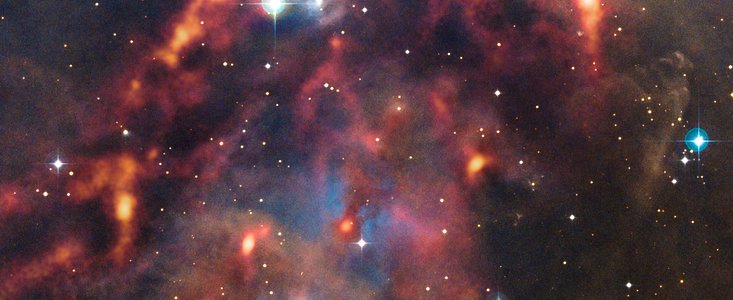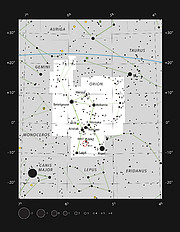Comunicato Stampa
Tenebre in fiamme
23 Gennaio 2013
Una nuova immagine dal telescopio APEX (Atacama Pathfinder Experiment) in Cile mostra una splendida vista delle nubi di polvere cosmica nella regione di Orione. Mentre queste dense nubi interstellari appaiono scure e opache nelle osservazioni in luce visibile, la camera LABOCA di APEX osserva il calore emesso dalla polvere e svela i nascondigli in cui si formano nuove stelle. Ma una di queste nubi oscure non è quel che sembra.
Nello spazio, le dense nubi di gas e polvere cosmica costiuiscono il luogo di nascita delle nuove stelle. In luce visibile, questa polvere è scura e opaca e nasconde le stelle dietro di sè così efficacemente che, quando l'astronomo William Herschel ne osservò una nella costellazione dello Scorpione nel 1774, pensò di aver trovato una regione senza stelle e così si dice abbia esclamato: "Qui c'è davvero un buco nel cielo!" [1]
Per meglio comprendere la formazione stellare, agli astronomi servono telescopi in grado di osservare a lunghezze d'onda maggiori, come la banda submillimetrica, in cui i grani scuri di polvere emettono invece che assorbire luce. APEX, sulla piana di Chajnantor nelle Ande cilene, è il più grande telescopio ad antenna singola per la banda submillimetrica che opera nell'emisfero australe ed è perciò ideale per gli astronomi che così studiano la nascita delle stelle.
Il complesso della nube molecolare di Orione, nella costellazione di Orione, a circa 1500 anni luce dalla Terra, è la regione di formazione stellare massiccia più vicina alla Terra e contiene un tesoro di nebulose brillanti, di nubi oscure e di giovani stelle. La nuova immagine mostra solo una parte di questo vasto complesso in luce visibile, a cui sono sovrapposti i dati di APEX, in brillanti toni arancio, che sembrano incendiare la nube scura. Spesso i grumi più brillanti visti da APEX corrispondono alle macchie più scure in luce visibile - il segno caratteristico di una densa nube di polvere che assorbe la luce visibile ma risplende a lunghezze d'onda submillimetriche, probabilmente una zona di formazione stellare.
La macchia brillante sotto al centro dell'immagine è la nebulosa NGC 1999. Questa regione - se vista in luce visibile - è quella che gli astronomi chiamano nebulosa a riflessione, in cui la debole luce bluastra delle stelle di sfondo viene riflessa dalle nubi di polvere. La nebulosa è illuminata soprattutto dalla radiazione energetica emessa dalla giovane stella V380 Orionis [2] che si annida all'interno. Al centro della nebulosa è evidente una chiazza scura, visibile ancor più chiaramente in una famosa immagine del telescopio spaziale Hubble della NASA/ESA.
Di solito una chiazza scura come questa indica una densa nube di polvere cosmica, che oscura le stelle e la nebulosa dietro di sè. Invece vediamo in questa immagine che la chiazza rimane incredibilmente scura, anche quando si aggiungono le osservazioni di APEX. Grazie a queste osservazioni di APEX combinate con osservazioni infrarosse di altri telescopi, gli astronomi ritengono che la macchia scura sia in realtà un buco o una cavità della nebulosa, scavata dal materiale che fluisce dalla stella V380 Orionis. Per questa volta, è davvero un buco nel cielo!
La regione raffigurata in questa immagine si trova circa due gradi a sud della grande e ben nota Nebulosa di Orione (Messier 42), che si vede verso il bordo superiore nella panoramica più ampia in luce visibile dalla DSS (Digitized Sky Survey).
Le osservazioni APEX usate in questa immagine sono state condotte da Thomas Stanke (ESO), Tom Megeath (University of Toledo, USA), e Amy Stutz (Max Planck Institute for Astronomy, Heidelberg, Germania). APEX è una collaborazione tra il Max Planck Institute for Radio Astronomy (MPIfR), l'Onsala Space Observatory (OSO) e l'ESO. La gestione di APEX a Chajnantor è affidata all'ESO.
Note
[1] In tedesco: "Hier ist wahrhaftig ein Loch im Himmel!"
[2] V380 Orionis ha una temperatura superficiale alta, intorno ai 10000 K (circa la stessa in gradi Celsius), quasi il doppio del Sole. La massa dovrebbe essere circa 3,5 volte quella del Sole.
Ulteriori Informazioni
L'ESO (European Southern Observatory, o Osservatorio Australe Europeo) è la principale organizzazione intergovernativa di Astronomia in Europa e l'osservatorio astronomico più produttivo al mondo. È sostenuto da 15 paesi: Austria, Belgio, Brasile, Danimarca, Finlandia, Francia, Germania, Gran Bretagna, Italia, Olanda, Portogallo, Repubblica Ceca, Spagna, Svezia, e Svizzera. L'ESO svolge un ambizioso programma che si concentra sulla progettazione, costruzione e gestione di potenti strumenti astronomici da terra che consentano agli astronomi di realizzare importanti scoperte scientifiche. L'ESO ha anche un ruolo di punta nel promuovere e organizzare la cooperazione nella ricerca astronomica. L'ESO gestisce tre siti osservativi unici al mondo in Cile: La Silla, Paranal e Chajnantor. Sul Paranal, l'ESO gestisce il Very Large Telescope, osservatorio astronomico d'avanguardia nella banda visibile e due telescopi per survey. VISTA, il più grande telescopio per survey al mondo, lavora nella banda infrarossa mentre il VST (VLT Survey Telescope) è il più grande telescopio progettato appositamente per produrre survey del cielo in luce visibile. L'ESO è il partner europeo di un telescopio astronomico di concetto rivoluzionario, ALMA, il più grande progetto astronomico esistente. L'ESO al momento sta progettando l'European Extremely Large Telescope o E-ELT (significa Telescopio Europeo Estremamente Grande), un telescopio da 39 metri che opera nell'ottico e infrarosso vicino e che diventerà "il più grande occhio del mondo rivolto al cielo".
Links
- La ricerca nella zona oscura di NGC 1999 qui presentata è descritta nell'articolo di T. Stanke et al, A&A 518, L94 (2010), disponibile anche come preprint.
Contatti
Thomas Stanke
ESO
Garching, Germany
Tel.: +49 89 3200 6116
E-mail: tstanke@eso.org
Douglas Pierce-Price
ESO ALMA/APEX Public Information Officer
Garching, Germany
Tel.: +49 89 3200 6759
E-mail: dpiercep@eso.org
Joerg Gasser (press contact Svizzera)
Rete di divulgazione scientifica dell'ESO
E-mail: eson-switzerland@eso.org
Sul Comunicato Stampa
| Comunicato Stampa N": | eso1304it-ch |
| Nome: | NGC 1999 |
| Tipo: | Milky Way : Nebula : Type : Star Formation |
| Facility: | Atacama Pathfinder Experiment |
| Instruments: | LABOCA |
| Science data: | 2010A&A...518L..94S |
Our use of Cookies
We use cookies that are essential for accessing our websites and using our services. We also use cookies to analyse, measure and improve our websites’ performance, to enable content sharing via social media and to display media content hosted on third-party platforms.
ESO Cookies Policy
The European Organisation for Astronomical Research in the Southern Hemisphere (ESO) is the pre-eminent intergovernmental science and technology organisation in astronomy. It carries out an ambitious programme focused on the design, construction and operation of powerful ground-based observing facilities for astronomy.
This Cookies Policy is intended to provide clarity by outlining the cookies used on the ESO public websites, their functions, the options you have for controlling them, and the ways you can contact us for additional details.
What are cookies?
Cookies are small pieces of data stored on your device by websites you visit. They serve various purposes, such as remembering login credentials and preferences and enhance your browsing experience.
Categories of cookies we use
Essential cookies (always active): These cookies are strictly necessary for the proper functioning of our website. Without these cookies, the website cannot operate correctly, and certain services, such as logging in or accessing secure areas, may not be available; because they are essential for the website’s operation, they cannot be disabled.
Functional Cookies: These cookies enhance your browsing experience by enabling additional features and personalization, such as remembering your preferences and settings. While not strictly necessary for the website to function, they improve usability and convenience; these cookies are only placed if you provide your consent.
Analytics cookies: These cookies collect information about how visitors interact with our website, such as which pages are visited most often and how users navigate the site. This data helps us improve website performance, optimize content, and enhance the user experience; these cookies are only placed if you provide your consent. We use the following analytics cookies.
Matomo Cookies:
This website uses Matomo (formerly Piwik), an open source software which enables the statistical analysis of website visits. Matomo uses cookies (text files) which are saved on your computer and which allow us to analyze how you use our website. The website user information generated by the cookies will only be saved on the servers of our IT Department. We use this information to analyze www.eso.org visits and to prepare reports on website activities. These data will not be disclosed to third parties.
On behalf of ESO, Matomo will use this information for the purpose of evaluating your use of the website, compiling reports on website activity and providing other services relating to website activity and internet usage.
Matomo cookies settings:
Additional Third-party cookies on ESO websites: some of our pages display content from external providers, e.g. YouTube.
Such third-party services are outside of ESO control and may, at any time, change their terms of service, use of cookies, etc.
YouTube: Some videos on the ESO website are embedded from ESO’s official YouTube channel. We have enabled YouTube’s privacy-enhanced mode, meaning that no cookies are set unless the user actively clicks on the video to play it. Additionally, in this mode, YouTube does not store any personally identifiable cookie data for embedded video playbacks. For more details, please refer to YouTube’s embedding videos information page.
Cookies can also be classified based on the following elements.
Regarding the domain, there are:
- First-party cookies, set by the website you are currently visiting. They are stored by the same domain that you are browsing and are used to enhance your experience on that site;
- Third-party cookies, set by a domain other than the one you are currently visiting.
As for their duration, cookies can be:
- Browser-session cookies, which are deleted when the user closes the browser;
- Stored cookies, which stay on the user's device for a predetermined period of time.
How to manage cookies
Cookie settings: You can modify your cookie choices for the ESO webpages at any time by clicking on the link Cookie settings at the bottom of any page.
In your browser: If you wish to delete cookies or instruct your browser to delete or block cookies by default, please visit the help pages of your browser:
Please be aware that if you delete or decline cookies, certain functionalities of our website may be not be available and your browsing experience may be affected.
You can set most browsers to prevent any cookies being placed on your device, but you may then have to manually adjust some preferences every time you visit a site/page. And some services and functionalities may not work properly at all (e.g. profile logging-in, shop check out).
Updates to the ESO Cookies Policy
The ESO Cookies Policy may be subject to future updates, which will be made available on this page.
Additional information
For any queries related to cookies, please contact: pdprATesoDOTorg.
As ESO public webpages are managed by our Department of Communication, your questions will be dealt with the support of the said Department.






